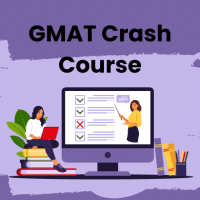GMAT Exam > GMAT Questions > Brian drives a certain part of his journey at...
Start Learning for Free
Brian drives a certain part of his journey at an average speed of 30 miles per hour and the rest at an average speed of 60 miles per hour. If he drives for 100 miles, is his average speed for the journey greater than 45 miles per hour?
(1) Brian drives for 30 miles per hour for twice the time than he drives for 60 miles per hour.
(2) Had Brian driven at an average speed of 40 miles per hour rather than 30 miles per hour, his average speed for the
journey would have been 48 miles per hour.
journey would have been 48 miles per hour.
- a)Statement (1) ALONE is sufficient, but statement (2) alone is
not sufficient to answer the question asked. - b)Statement (2) ALONE is sufficient, but statement (1) alone is
not sufficient to answer the question asked - c)BOTH statements (1) and (2) TOGETHER are sufficient to
answer the question asked, but NEITHER statement ALONE
is sufficient to answer the question asked - d)EACH statement ALONE is sufficient to answer the question
asked. - e)Statements (1) and (2) TOGETHER are NOT sufficient to
answer the question asked, and additional data specific to the
problem are needed.
Correct answer is option 'D'. Can you explain this answer?
Verified Answer
Brian drives a certain part of his journey at an average speed of 30 m...
Step 1 & 2: Understand Question and Draw Inference
- Let the distance for which he drives for 30 miles per hour be x miles.
- Distance for which he drives for 60 miles per hour = 100 – x miles
Step 3 : Analyze Statement 1 independent
(1) Brian drives for 30 miles per hour for twice the time than he drives for 60 miles per hour.
As we know the values of x, we can find if 
Sufficient to answer
Step 4 : Analyze Statement 2 independent
(2) Had Brian driven at an average speed of 40 miles per hour rather than 30 miles per hour, his average speed for the journey would have been 48 miles per hour.
As we know the values of x, we can find if 
Sufficient to answer.
Step 5: Analyze Both Statements Together (if needed)
Since, we have a unique answers from steps 3 and 4, this step is not needed.
Answer: D
Answer: D

|
Explore Courses for GMAT exam
|

|
Question Description
Brian drives a certain part of his journey at an average speed of 30 miles per hour and the rest at an average speed of 60 miles per hour. If he drives for 100 miles, is his average speed for the journey greater than 45 miles per hour?(1) Brian drives for 30 miles per hour for twice the time than he drives for 60 miles per hour.(2) Had Brian driven at an average speed of 40 miles per hour rather than 30 miles per hour, his average speed for thejourney would have been 48 miles per hour.a)Statement (1) ALONE is sufficient, but statement (2) alone isnot sufficient to answer the question asked.b)Statement (2) ALONE is sufficient, but statement (1) alone isnot sufficient to answer the question askedc)BOTH statements (1) and (2) TOGETHER are sufficient toanswer the question asked, but NEITHER statement ALONEis sufficient to answer the question askedd)EACH statement ALONE is sufficient to answer the questionasked.e)Statements (1) and (2) TOGETHER are NOT sufficient toanswer the question asked, and additional data specific to theproblem are needed.Correct answer is option 'D'. Can you explain this answer? for GMAT 2025 is part of GMAT preparation. The Question and answers have been prepared according to the GMAT exam syllabus. Information about Brian drives a certain part of his journey at an average speed of 30 miles per hour and the rest at an average speed of 60 miles per hour. If he drives for 100 miles, is his average speed for the journey greater than 45 miles per hour?(1) Brian drives for 30 miles per hour for twice the time than he drives for 60 miles per hour.(2) Had Brian driven at an average speed of 40 miles per hour rather than 30 miles per hour, his average speed for thejourney would have been 48 miles per hour.a)Statement (1) ALONE is sufficient, but statement (2) alone isnot sufficient to answer the question asked.b)Statement (2) ALONE is sufficient, but statement (1) alone isnot sufficient to answer the question askedc)BOTH statements (1) and (2) TOGETHER are sufficient toanswer the question asked, but NEITHER statement ALONEis sufficient to answer the question askedd)EACH statement ALONE is sufficient to answer the questionasked.e)Statements (1) and (2) TOGETHER are NOT sufficient toanswer the question asked, and additional data specific to theproblem are needed.Correct answer is option 'D'. Can you explain this answer? covers all topics & solutions for GMAT 2025 Exam. Find important definitions, questions, meanings, examples, exercises and tests below for Brian drives a certain part of his journey at an average speed of 30 miles per hour and the rest at an average speed of 60 miles per hour. If he drives for 100 miles, is his average speed for the journey greater than 45 miles per hour?(1) Brian drives for 30 miles per hour for twice the time than he drives for 60 miles per hour.(2) Had Brian driven at an average speed of 40 miles per hour rather than 30 miles per hour, his average speed for thejourney would have been 48 miles per hour.a)Statement (1) ALONE is sufficient, but statement (2) alone isnot sufficient to answer the question asked.b)Statement (2) ALONE is sufficient, but statement (1) alone isnot sufficient to answer the question askedc)BOTH statements (1) and (2) TOGETHER are sufficient toanswer the question asked, but NEITHER statement ALONEis sufficient to answer the question askedd)EACH statement ALONE is sufficient to answer the questionasked.e)Statements (1) and (2) TOGETHER are NOT sufficient toanswer the question asked, and additional data specific to theproblem are needed.Correct answer is option 'D'. Can you explain this answer?.
Brian drives a certain part of his journey at an average speed of 30 miles per hour and the rest at an average speed of 60 miles per hour. If he drives for 100 miles, is his average speed for the journey greater than 45 miles per hour?(1) Brian drives for 30 miles per hour for twice the time than he drives for 60 miles per hour.(2) Had Brian driven at an average speed of 40 miles per hour rather than 30 miles per hour, his average speed for thejourney would have been 48 miles per hour.a)Statement (1) ALONE is sufficient, but statement (2) alone isnot sufficient to answer the question asked.b)Statement (2) ALONE is sufficient, but statement (1) alone isnot sufficient to answer the question askedc)BOTH statements (1) and (2) TOGETHER are sufficient toanswer the question asked, but NEITHER statement ALONEis sufficient to answer the question askedd)EACH statement ALONE is sufficient to answer the questionasked.e)Statements (1) and (2) TOGETHER are NOT sufficient toanswer the question asked, and additional data specific to theproblem are needed.Correct answer is option 'D'. Can you explain this answer? for GMAT 2025 is part of GMAT preparation. The Question and answers have been prepared according to the GMAT exam syllabus. Information about Brian drives a certain part of his journey at an average speed of 30 miles per hour and the rest at an average speed of 60 miles per hour. If he drives for 100 miles, is his average speed for the journey greater than 45 miles per hour?(1) Brian drives for 30 miles per hour for twice the time than he drives for 60 miles per hour.(2) Had Brian driven at an average speed of 40 miles per hour rather than 30 miles per hour, his average speed for thejourney would have been 48 miles per hour.a)Statement (1) ALONE is sufficient, but statement (2) alone isnot sufficient to answer the question asked.b)Statement (2) ALONE is sufficient, but statement (1) alone isnot sufficient to answer the question askedc)BOTH statements (1) and (2) TOGETHER are sufficient toanswer the question asked, but NEITHER statement ALONEis sufficient to answer the question askedd)EACH statement ALONE is sufficient to answer the questionasked.e)Statements (1) and (2) TOGETHER are NOT sufficient toanswer the question asked, and additional data specific to theproblem are needed.Correct answer is option 'D'. Can you explain this answer? covers all topics & solutions for GMAT 2025 Exam. Find important definitions, questions, meanings, examples, exercises and tests below for Brian drives a certain part of his journey at an average speed of 30 miles per hour and the rest at an average speed of 60 miles per hour. If he drives for 100 miles, is his average speed for the journey greater than 45 miles per hour?(1) Brian drives for 30 miles per hour for twice the time than he drives for 60 miles per hour.(2) Had Brian driven at an average speed of 40 miles per hour rather than 30 miles per hour, his average speed for thejourney would have been 48 miles per hour.a)Statement (1) ALONE is sufficient, but statement (2) alone isnot sufficient to answer the question asked.b)Statement (2) ALONE is sufficient, but statement (1) alone isnot sufficient to answer the question askedc)BOTH statements (1) and (2) TOGETHER are sufficient toanswer the question asked, but NEITHER statement ALONEis sufficient to answer the question askedd)EACH statement ALONE is sufficient to answer the questionasked.e)Statements (1) and (2) TOGETHER are NOT sufficient toanswer the question asked, and additional data specific to theproblem are needed.Correct answer is option 'D'. Can you explain this answer?.
Solutions for Brian drives a certain part of his journey at an average speed of 30 miles per hour and the rest at an average speed of 60 miles per hour. If he drives for 100 miles, is his average speed for the journey greater than 45 miles per hour?(1) Brian drives for 30 miles per hour for twice the time than he drives for 60 miles per hour.(2) Had Brian driven at an average speed of 40 miles per hour rather than 30 miles per hour, his average speed for thejourney would have been 48 miles per hour.a)Statement (1) ALONE is sufficient, but statement (2) alone isnot sufficient to answer the question asked.b)Statement (2) ALONE is sufficient, but statement (1) alone isnot sufficient to answer the question askedc)BOTH statements (1) and (2) TOGETHER are sufficient toanswer the question asked, but NEITHER statement ALONEis sufficient to answer the question askedd)EACH statement ALONE is sufficient to answer the questionasked.e)Statements (1) and (2) TOGETHER are NOT sufficient toanswer the question asked, and additional data specific to theproblem are needed.Correct answer is option 'D'. Can you explain this answer? in English & in Hindi are available as part of our courses for GMAT.
Download more important topics, notes, lectures and mock test series for GMAT Exam by signing up for free.
Here you can find the meaning of Brian drives a certain part of his journey at an average speed of 30 miles per hour and the rest at an average speed of 60 miles per hour. If he drives for 100 miles, is his average speed for the journey greater than 45 miles per hour?(1) Brian drives for 30 miles per hour for twice the time than he drives for 60 miles per hour.(2) Had Brian driven at an average speed of 40 miles per hour rather than 30 miles per hour, his average speed for thejourney would have been 48 miles per hour.a)Statement (1) ALONE is sufficient, but statement (2) alone isnot sufficient to answer the question asked.b)Statement (2) ALONE is sufficient, but statement (1) alone isnot sufficient to answer the question askedc)BOTH statements (1) and (2) TOGETHER are sufficient toanswer the question asked, but NEITHER statement ALONEis sufficient to answer the question askedd)EACH statement ALONE is sufficient to answer the questionasked.e)Statements (1) and (2) TOGETHER are NOT sufficient toanswer the question asked, and additional data specific to theproblem are needed.Correct answer is option 'D'. Can you explain this answer? defined & explained in the simplest way possible. Besides giving the explanation of
Brian drives a certain part of his journey at an average speed of 30 miles per hour and the rest at an average speed of 60 miles per hour. If he drives for 100 miles, is his average speed for the journey greater than 45 miles per hour?(1) Brian drives for 30 miles per hour for twice the time than he drives for 60 miles per hour.(2) Had Brian driven at an average speed of 40 miles per hour rather than 30 miles per hour, his average speed for thejourney would have been 48 miles per hour.a)Statement (1) ALONE is sufficient, but statement (2) alone isnot sufficient to answer the question asked.b)Statement (2) ALONE is sufficient, but statement (1) alone isnot sufficient to answer the question askedc)BOTH statements (1) and (2) TOGETHER are sufficient toanswer the question asked, but NEITHER statement ALONEis sufficient to answer the question askedd)EACH statement ALONE is sufficient to answer the questionasked.e)Statements (1) and (2) TOGETHER are NOT sufficient toanswer the question asked, and additional data specific to theproblem are needed.Correct answer is option 'D'. Can you explain this answer?, a detailed solution for Brian drives a certain part of his journey at an average speed of 30 miles per hour and the rest at an average speed of 60 miles per hour. If he drives for 100 miles, is his average speed for the journey greater than 45 miles per hour?(1) Brian drives for 30 miles per hour for twice the time than he drives for 60 miles per hour.(2) Had Brian driven at an average speed of 40 miles per hour rather than 30 miles per hour, his average speed for thejourney would have been 48 miles per hour.a)Statement (1) ALONE is sufficient, but statement (2) alone isnot sufficient to answer the question asked.b)Statement (2) ALONE is sufficient, but statement (1) alone isnot sufficient to answer the question askedc)BOTH statements (1) and (2) TOGETHER are sufficient toanswer the question asked, but NEITHER statement ALONEis sufficient to answer the question askedd)EACH statement ALONE is sufficient to answer the questionasked.e)Statements (1) and (2) TOGETHER are NOT sufficient toanswer the question asked, and additional data specific to theproblem are needed.Correct answer is option 'D'. Can you explain this answer? has been provided alongside types of Brian drives a certain part of his journey at an average speed of 30 miles per hour and the rest at an average speed of 60 miles per hour. If he drives for 100 miles, is his average speed for the journey greater than 45 miles per hour?(1) Brian drives for 30 miles per hour for twice the time than he drives for 60 miles per hour.(2) Had Brian driven at an average speed of 40 miles per hour rather than 30 miles per hour, his average speed for thejourney would have been 48 miles per hour.a)Statement (1) ALONE is sufficient, but statement (2) alone isnot sufficient to answer the question asked.b)Statement (2) ALONE is sufficient, but statement (1) alone isnot sufficient to answer the question askedc)BOTH statements (1) and (2) TOGETHER are sufficient toanswer the question asked, but NEITHER statement ALONEis sufficient to answer the question askedd)EACH statement ALONE is sufficient to answer the questionasked.e)Statements (1) and (2) TOGETHER are NOT sufficient toanswer the question asked, and additional data specific to theproblem are needed.Correct answer is option 'D'. Can you explain this answer? theory, EduRev gives you an
ample number of questions to practice Brian drives a certain part of his journey at an average speed of 30 miles per hour and the rest at an average speed of 60 miles per hour. If he drives for 100 miles, is his average speed for the journey greater than 45 miles per hour?(1) Brian drives for 30 miles per hour for twice the time than he drives for 60 miles per hour.(2) Had Brian driven at an average speed of 40 miles per hour rather than 30 miles per hour, his average speed for thejourney would have been 48 miles per hour.a)Statement (1) ALONE is sufficient, but statement (2) alone isnot sufficient to answer the question asked.b)Statement (2) ALONE is sufficient, but statement (1) alone isnot sufficient to answer the question askedc)BOTH statements (1) and (2) TOGETHER are sufficient toanswer the question asked, but NEITHER statement ALONEis sufficient to answer the question askedd)EACH statement ALONE is sufficient to answer the questionasked.e)Statements (1) and (2) TOGETHER are NOT sufficient toanswer the question asked, and additional data specific to theproblem are needed.Correct answer is option 'D'. Can you explain this answer? tests, examples and also practice GMAT tests.

|
Explore Courses for GMAT exam
|

|
Signup for Free!
Signup to see your scores go up within 7 days! Learn & Practice with 1000+ FREE Notes, Videos & Tests.


















